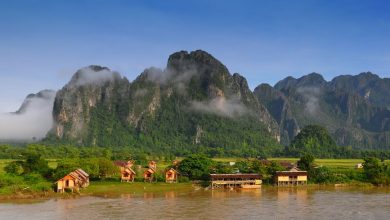History
Though the recorded data about the history of Laos begins with the unified state to the emergence of Lan Xang Kingdom in 1353, historical research shows that the multiethnic state existed before the founding of the Kingdom of Lan Xang. Based on the artifacts collected the first people who inhabited Laos lived by hunting and gathering with stone tools in northern regions. During the 1st millennium BC, Astro-Asiatic people have evolved into a more multifaceted agriculturist civilization accountable for creation of funeral urns on the Plain of Jars. They are believed to be the ancestors of the Lao Theung (upland Lao) ethnic group.
It was during the 7th Century when a group of linguistic Tais from Yunan Southern China start migrating to the northern areas of Burma, Laos, Thailand and Vietnam. These people settled along the Mekong River and began to form communities called <i>mandalas</i> or <i> muangs</i>. Steadily, their settlement was established further south of the Mekong River in Laos. Muang Sua was the name given to Luang Prabang following it conquest in the later part of 7th century. It was became the Kingdom of Sri Sattanak, a name associated with the legendary Naga (mythical snake) who said to have dug the Mekong riverbed.
It was in the second half of the 8th century when Khmer Empire under Indravarman I started expanding the empire towards the territories of Sipsong Panna on the upper part of Mekong river. By the year 1185 to 1191 Muang Sua experienced a brief period of Khmer suzerainty under Jayavarman VII. The Khmer were able to maintain their empire till 1253 until the Mongols invaded Laos from the north. The ruler of Thai dynasty in Sukhothai made himself the agent of Mongol interest to eliminate the vestiges of Khmer and Cham power in central Laos. Upon the withdrawal of the Mongols, the Siamese dynasty of Sukhothai was formed.
The first Laotian state was founded was the Lan Xang Kingdom formed in 1353 by exiled Laotian prince Fa Ngum. Fa Ngum married one of the daughters of a Khmer King and in the mid-14th century he recruited 10,000 armies to regain control of the parts of Laos which had fallen by the Sukhothai Empire. In 1354 Fa Ngum organized the conquered principalities into muang and founded the kingdom of Lan Xang (million elephants), in which he was crowned as King. Lan Xang kingdom extended from the border of China to Southern Laos, and was considered to be one of the largest kingdoms in Southeast Asia at that time.
The kingdom of Lan Xang remained largely unified and powerful over 300 years. Though all of the principalities were considered one unified kingdom, the supervision of the kingdom remained more regionalized. The King ruled and influenced his direct town and surroundings while it is the lord of each muang who established their own rules and taxes in each individual region.
During the Lan Xang period, Theravada Buddhism in Laos was introduced. Fa Ngun was also attributed for bringing the scared Phra Bang Buddha to Luang Prabang from Khmer.
In 1960, the Kingdom of Lan Xang fell prey to a series of rival claimants to its throne which resulted to the internal division and pressure from neighboring kingdoms and caused the split of three warring kingdoms centred on Luang Prabang, Vientiane and Champasak. The division caused the region to become vulnerable to attacks from outside invaders and by the late 18th century all three of the Lao Kingdoms had surrendered to Siam. Laos became a Siamese satellite state in 1829, despite this development; Laos frequently rebelled and fought ferociously to regain its independence.
In the early part of 19th century the French started to emerge in the region, pronouncing Cambodia as a colony in the mid-19th century. It was in 1893 when the French were able to force the Siamese to concede Laos to the French administration. Despite the fact that the French had a direct control over most of the country, Luang Prabang’s royal family and home were preserve and the local government were allowed to function independently under the rule of King Zakarine.
In World War II the French position in Indochina was weakened. The French administration came to an end and Japanese briefly occupied French Indochina, including Laos. Prior to Japanese submission, King Sisavang Vong of Luang Prabang was induced to declare independence from France in 1945. Vientiane and Champassak united with Luang Prabang in September 1945 to form an independent government under the Free Lao (Lao Issara) banner. It was early 1946 when the French troops reoccupied the country and reestablished its control over the country.
Laos independence was formally recognized by the French Union in 1949 and remained a member of the Union until 1953. A Royal Lao Army was formed; a number of clinics, hospitals and schools were established. Despite being economically dependent to France the country was internationally recognized as a fully independent institutional state on 1954 at Geneva Convention on Indochina. The first coalition government was formed in 1957. Price Souvanna Phouma, the royal prime minister and Pathet Lao leader Prince Souphanouvong agreed in re-establishment of unified government. It was in 1958 when the coalition government collapsed and the rightist forces took over the government.
A second Geneva Convention was held in 1961 to 1962 for country’s neutrality and independence. The Neutralist was represented by Quinim, the rightists by Phoui Sananikone and Phoumi Vongvichit for Pathet Lao. After the agreement was reached the signatories accused each other of violating terms of agreement and the war in Vietnam engulfed Laos.
The growing American and North Vietnamese military presence in the country drew Laos into the second Indochina war. For almost a decade, Laos was imperiled to extremely heavy bombing as US sought to destroy the portion of Ho Chi Minh Trail that passed through eastern Laos. During the 9 years of war the US executed more than 580 000 bombing missions over Laos and released over two tons of bombs per person. The war continued until 1973 by the time the Vietnamese ceasefire was negotiated Laos had the dubious reputation of being the most bombed country in the history of welfare.
The fall of Phnom Penh and Saigon to Communists in 1975 ended the war in Indochina. The country was liberated from the American influence and Royal control. A new coalition government known as Lao People’s Democratic Republic was established. The new government imposed centralized economic decision-making towards the country’s socialism. The harsh policies and deteriorating economic conditions along with the government efforts to enforce political control prompted a migration of lowland Laos and ethnic Hmong from Laos. Collectivism policy of the government led to closure of numerous businesses after 1975. However during 1981 the government reversed its position on the management of economy and the country’s economy was liberalized in 1986.
The country’s diplomatic overtures with its neighboring countries started during 1990s and by 1995 the US lifted its ban on aid to the country. A number of incidents of insurgency against the government occur during 2003 to 2007. There are still a number of anti-Communist rebel groups that has been protesting the government’s unwillingness to embrace democratic reforms.



